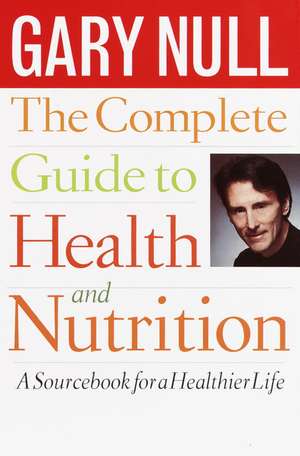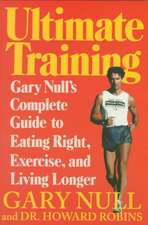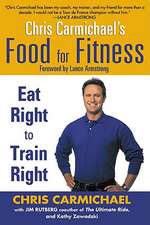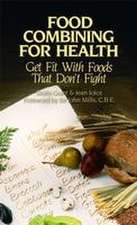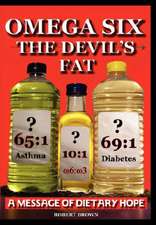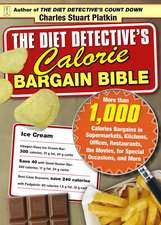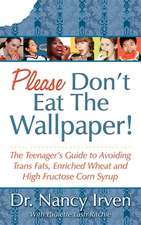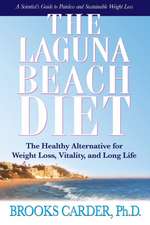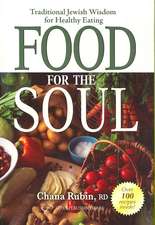The Complete Guide to Health and Nutrition: A Source Book for a Healthier Life
Autor Gary Null Martin Feldmanen Limba Engleză Paperback – 31 iul 1986
Yes, you can feel better, look better, and extend the best years of your life through proper nutrition and exercise. And there is no better guide to optimum health than this classic reference and sourcebook.
Compiled by Gary Null, Ph.D., America's leading health and fitness expert, a TV regular and host of his own nationally syndicated radio program, this invaluable resource offers a comprehensive overview of protein, carbohydrates, lipids, vitamins and minerals with the facts about their role in maintaining and restoring health.
Learn what's in the food you eat and what it can do for--and to--you. Discover the pros and cons of supplements, which to take, how to take them and safe and effective dosages for each. Find out:
The best way to lower high blood pressure and lose weight
How to know if you're getting enough--or too much--protein
The role of sugar in cardiovascular disease
The best foods--and supplements--to meet changing nutritional needs
Why exercise is more important than diet for weight control, and which exercise is best of all
The vitamin that slows down the aging process
Why you may be inviting heart disease when you eliminate all cholesterol-containing foods from your diet
Gary Null cuts through the myths and hype and presents the facts: everything you need to know about living well every day of your life.
Preț: 175.80 lei
Nou
Puncte Express: 264
Preț estimativ în valută:
33.64€ • 35.08$ • 27.96£
33.64€ • 35.08$ • 27.96£
Carte disponibilă
Livrare economică 28 februarie-14 martie
Preluare comenzi: 021 569.72.76
Specificații
ISBN-13: 9780440506126
ISBN-10: 0440506123
Pagini: 608
Dimensiuni: 155 x 234 x 33 mm
Greutate: 0.86 kg
Editura: Dell Publishing Company
ISBN-10: 0440506123
Pagini: 608
Dimensiuni: 155 x 234 x 33 mm
Greutate: 0.86 kg
Editura: Dell Publishing Company
Notă biografică
Gary Null, Ph.D., is the author of over fifty books, including Get Healthy Now!, Gary Null's Ultimate Anti-Aging Program, and The Encyclopedia of Natural Healing. A sought-after lecturer, educator, and environmentalist, he is also the host of the longest-running nationally syndicated health radio program in America, Natural Living with Gary Null. He lives in New York City.
Extras
INTRODUCTION
Gary Null's Complete Guide to Health and Nutrition is the most complete and authoritative popular work of its kind. Five years in the making, it explains fully and simply the basics of health and nutrition: what's in the food we eat, how it affects us, and how we can make ourselves healthier through good nutrition.
The Complete Guide is unique in the thoroughness and objectivity of its viewpoint. Nutrition arouses strong emotions in many of us, and some researchers let their emotions guide them toward one or another particular philosophy of health: "alternative" medicine, "holistic" therapy, "New Age" beliefs, or the orthodox, traditional methods of health care. And many of these adherents let their presentation of facts be guided by their opinions.
Gary Null lets his opinions be guided by the facts. Avoiding all prejudiced viewpoints, he gathers every important piece of research on every important subject: vitamins, minerals, fats, carbohydrates, protein. Thousands of books and articles have been read, and more than 2,000 experts in diverse fields have either been consulted or interviewed in establishing the real facts of each particular problem.. From this mountain of material Gary Null has distilled a concise, accurate statement of everything that's known about health and nutrition. To get the same wealth of information you would have to consult thirty to fifty separate books in the same field.
But the Complete Guide is not simply a reference book; it is a source book for a healthier life. When all the facts support a particular position on some issue in diet and nutrition, Gary Null does not hesitate to state that position strongly and back it up with sound practical advice. He confronts all the complex health issues facing us today and answers the questions his readers will be asking. How much protein do I need? Is vitamin E really effective in treating heart disease? Which vegetables supply the highest fiber content? Questions like these are answered not only in authoritative explanations but in valuable charts and diagrams as well. And sensitive issues such as sugar and cholesterol are presented not only as matters of health but as economic and political issues.
With Gary Null's Complete Guide to Health and Nutrition, readers can stop guessing--and worrying--about what's in the food they eat. They can get all the knowledge amassed by scientific research, and learn how to apply that knowledge to their own lives.
Martin Feldman, M.D.
New York City, 1984
PROTEIN
And God said, Behold, I have given you every herb bearing seed, which is upon the face of all the earth, and every tree, in the which is the fruit of a tree yielding seed; to you it shall be for meat.
--Genesis 1:29
If I were to do a word association test with you and I mentioned the word protein, the first thing to come to your mind would probably be meat.
After the term meat, no doubt you would mention chicken, hamburger, steak, veal--the flesh of an animal.
If I said, "high-protein diet," most likely you would imagine lots of red meat would be included.
If you are like most people, you probably have no idea how many grams of protein you need every day. You may have heard of the concept of complementing proteins but are probably vague about how it's done. And if you are like most people, you have no idea how to evaluate the net protein utilization of a particular food.
If you had to eliminate meat from your diet, would you be able to obtain enough quality protein?
In America today, we are faced with the notion that protein is synonymous with meat, our primary source, and that without a substantial amount of meat in the diet, we would be suffering from gross protein deficiencies. Many people believe they must eat meat every day, often three times a day. They'll consume ham or bacon for breakfast; luncheon meat such as salami, bologna, frankfurters, or hamburgers for lunch; and roast beef, fish, chicken, or steak for dinner. If you are an athlete, you will almost surely at some time in your training take high-protein supplements.
Serious problems arise as a result of the gross ignorance and misinformation prevalent on a subject so essential for good health. Very few people know what protein truly is, why we need it, what its best sources and its worst sources are, what are the toxic forms of protein and the toxic by-products associated with it, what is the most easily digested protein, how we should combine proteins, and how much protein we need as we age.
Family No. I: The Typical American High Protein Diet
If I were to ask you whether a seventeen-year-old and sixty-year-old woman require the same amount of protein, what would you say? As a point of fact, if you went into the average person's home and joined their family for dinner, you might sit down at the table with a mother, father, daughter, son, and possibly a grandparent. In all probability, all of them would receive the same amount of a protein food. This would usually be a meat/flesh item. But clearly the daughter and son, since they are growing, have a greater need for quality protein; the wife, who weighs fifty pounds less than her husband, has less need for protein than her husband; and the grandparent has still less need due to both age and the difficulty of digesting protein. Instead of offering each person the type and quantity of protein he or she needs for optimal health, we give protein in the same amount to every person irrespective of age or special circumstance.
When you are going in for surgery, when you are pregnant or lactating, or when you are under stress, exercising regularly, or growing, you require more protein than under normal conditions.
The average person's lack of knowledge on protein is as great as their ignorance concerning carbohydrates and the distinction between the empty calories from white sugar and the much better utilized calories from, for example, brown rice.
We must now take a careful look at protein to see what role it plays in our life.
To many Americans, good nutrition means protein. They know they need something called protein. As a result, they usually take too much. Most of our protein requirements could be met with about six ounces of complete protein a day. It's been estimated that the average American consumes upward of 100 grams of protein a day. That may be almost double what we actually need.
Let's sit down for dinner with that typical American family mentioned earlier. They associate meat with strength, well-developed musculature, and an active, hearty life. They think of their heroes--the athlete, the cowboy, the rugged outdoorsman--as meat eaters. And they believe the strength of these mythlike figures somehow derives from regular consumption of beefsteak.
The father, our host tonight, is proud that, as his income has increased, steak has appeared more and more frequently at his dinner table, replacing chicken, ground meat, veal, pork, and other cuts of meat that used to be less expensive. As part of the upper middle class, he feels proud that he can provide his family with the fruits of his labor. He urges his young son to "eat hearty"--and eating hearty means, to him, eating plenty of good, red meat. It doesn't occur to him that the diet he is urging on his offspring might be--at best--too much of a good thing.
The Advantages of Meat
Now in one sense, father does know best. Meat does have an advantage as a source of protein--not just father's favored steak, but all meats cut directly from the animal: veal, pork, lamb, chicken, turkey, etc. (This advantage does not necessarily hold for sausage, luncheon meats, hot dogs, chicken rolls, or other processed meats.) Meats are among the foods that supply complete protein: they contain all eight of the essential amino acids, the building blocks of protein. And they also supply other nutrients, such as iron and B vitamins, in which many vegetables are deficient. They contain fats we can use for energy, heat insulation, and a variety of metabolic functions. Many of our organs, including our nerves, can make good use of this fat (although unsaturated fats from vegetable or fish sources would be preferable).
However, father is probably not aware that, along with those amino acids, B vitamins, and saturated fats, his family is also taking into the body some unwanted visitors.
Chemicals in Your Meat
For instance, along with the roast beef that they are eating tonight, they might be obtaining some type of growth-stimulating hormones, even the banned DES--diethylstilbestrol--the artificial sex hormones that were given to women all over America in the 1950s and 1960s in order to prevent miscarriage. It was later found to be ineffective and to have carcinogenic consequences for the daughters and sons born to women who took it. DES was also fed to beef cattle because it slows down the animals' metabolism, making them fatter quicker. Though it is now banned for such use, illegal residues still appear.
That juicy roast beef would also supply them with unwanted antibiotics. These are administered to the cattle primarily because a large percentage of feedlot animals are fed as much as thirty pounds of grain a day, but they can only transform the food into three or four pounds of muscle and fat. That enormous overfeeding causes painful liver abscesses which in turn affect profits. So the cattle are simply given antibiotics such as oxytetracycline.
When animals are kept crowded together in close confinement, standing knee deep in excrement, fed twenty-four hours a day under bright lights on conveyor belts, they are prone to epidemic diseases such as respiratory ailments, foot rot, and diarrhea. For further protection, they are given additional medication such as streptomycin, another antibiotic.
Nor is that the only tampering. The cattle are also given tranquilizers so they will not mind their miserable, cramped existence, and will eat despite their lack of exercise.
The animals, of course, can pass on to the consumer, through their flesh, many of the chemicals that were given them to turn them into mechanized feeding machines. You can't really insulate yourself from this chemical abuse because there is no listing on the steak or roast beef of all the chemicals used--more than 2,700 chemicals are allowed in the processing of meats.
Eating these unwelcome additives along with your meat could have serious consequences for your health and that of your family. Imagine the mother of the family you are visiting sitting at the dining table eating that roast beef, as she has been eating it nearly every day for years. She believes that it provides her with strength. At the same time, suppose she has been suffering from localized infections and has been taking antibiotics on and off for twenty years. Between the antibiotics she has been taking deliberately, and those used in animal production coming through her food supply, it is entirely possible that the bacteria in her body have developed an immunity to many if not all the antibiotics she has tried. If she were to come down with a severe infection, the antibiotics might not work as a result. She could die from bacterial death due to antibiotic-resistant bacteria. She would not know that her bacterial infection had developed this resistance in part because of her constant ingestion of highly potent antibiotics. It is conceivable that the chemicals in the meat she was eating for strength could ultimately cause her to succumb to pneumonia or some other infection.
If the animals were kept in clean, spacious surroundings, these antibiotics would rarely be necessary. However, because of the manure and encrusted filth present in cattle and pig pens, they are a necessary precaution against rampant disease. Unfortunately, the fact they are used routinely no doubt encourages the agribusiness dealers who handle the cattle and hogs to be less interested in animal sanitation than antibiotics.
Nor are antibiotics and tranquilizers the only chemicals your hosts may be eating tonight with the roast beef. The cow that provided the beef had to eat to get so fat and juicy. Unfortunately, she is not likely to have eaten grains or soybeans grown on an organic farm--your hosts tonight don't buy their beef in health food stores. As a result, that cow--like most of us--gobbled down quite a quantity of pesticide along with her feed. Her metabolism stored it up and concentrated it in her flesh--especially the liver and fat tissues, but the rest of her body, too--to pass along to you.
What's Missing in Meat
Antibiotics and other chemicals are not the only obstacles to health our typical American family faces as a result of making meat the main element of each meal.
Let's look more closely at father's plate. Several slices of roast beef fill most of it. He may like his roast beef sliced thin, but he piles up the slices on his plate. There's hardly any room left on the side for his baked potato. Beside his plate, in a bowl so small you could hold it in the palm of your hand, sits a salad of iceberg lettuce and bottled dressing.
What he's getting in this meal is a high portion of fat and chemical residues. What he is missing is an adequate portion of vitamins and minerals.
True, the meat supplies complete protein--but possibly more than he really needs. And by the time he finishes a pound or so of roast beef, he's really not very interested in eating his vegetables, such as they are. He throws a few pats of butter onto his potato--still more saturated fat--eats the inside and discards the skin as waste. He doesn't realize he's throwing out a fine source of fiber and vitamin C--neither of which is to be found in his roast beef. And by eating so little salad, he's shortchanging himself of magnesium--a mineral found in leafy greens and needed for the proper functioning of nerve tissue and of the muscles he thinks his meat is taking care of. Still more pertinent to a particular problem of his, he is losing another source of fiber.
Father's overreliance on meat at the expense of other foods--particularly whole grains, legumes, fruits, and vegetables--has led to a lack of fiber in his diet. Fiber is necessary for maintaining healthy bowel movements. It stimulates peristalsis, the rhythmic wavelike movements that move food through the intestine. Fiber also allows more moisture in the fecal matter so it does not stagnate.
Father has thought it to be completely natural for the past twenty years to be taking a laxative virtually every day. He does not realize he is addicted to them or that they actually contribute to his constipation.
As a result of lack of fiber, the transit time of food through his digestive system, instead of being twenty-four to thirty-six hours--normal for optimal health--is incredibly slow, often taking upward of ninety hours from the time it is ingested until it is passed through the body. During these ninety hours, disease-producing microorganisms can multiply, putrifying the protein in his intestines. Picture what happens to meat dropped by mistake behind the stove for four days and left there to rot. And don't forget that the body temperature is 98.6° Fahrenheit. The slowness and pressure of the progress of food through his intestines could contribute to him developing diverticulitis, small pouchlike bumps in the intestine where bacteria and putrified matter collect in a sort of chronic infection. It also causes poor absorption of the nutrients in the food he eats. All this because the amount of protein that he eats has replaced the more nourishing fiber-rich foods in his diet.
If he is not careful, he--or anyone in his family--could end up with cancer of the colon. In fact, the National Cancer Institute has released a five-year study that implicates high consumption of beef in cancer of the colon.
Summary
In the mind of most Americans, protein has almost a glamorous image, as the essence of nutrition.
We pay very little attention to how much we actually need based on our biological individuality. This amount varies with our weight, age, and the amount of stress we are under. Pregnant and lactating women also have increased protein needs.
While meat is an excellent source of complete protein and B vitamins, the typical American diet, with its emphasis on beef, pork, and processed meats, has serious drawbacks. Marbled beef, long considered the prestige meat, is high in saturated fats, as are pork and processed meats. Beef cattle are fed a wide range of growth-stimulating hormones, antibiotics, and tranquilizers. DES, now banned because of its carcinogenic effects, was one of these hormones. But there remain nearly 3,000 chemicals with which it is still legal to douse cattle, and any of these can affect your health. Antibiotics, for example, can alter your intestinal flora, and can become ineffectual when taken repeatedly. In addition, pesticides and other chemicals from cattle feed concentrate in the animals' flesh (particularly in the liver).
Finally, overreliance on protein at the expense of high-fiber foods (grains, beans, fibers, fruit) can cause constipation, diverticulitis, cancer of the colon, and other diseases of the intestines.
Dangers of a High-Protein Weight-Loss Diet
The teenage daughter sitting at the table is one of twenty million Americans who are regularly on high-protein crash reducing diets. She is under the impression that by eating a great deal of protein, she is consuming a minimum amount of calories, and so will lose weight. Nothing could be further from the truth. In point of fact, eight ounces of beef contains upward of 500 calories, because beef is only approximately 22 percent protein. It contains an appreciable amount of fat, and the rest is water. She could be eating three or four giant salads, including several vegetables, raw or cooked, crammed with high quantities of nourishing vitamins and minerals, for 300 to 400 calories. They would also provide her with adequate fiber bulk, which would make her feel full, in addition to aiding in peristalsis. Instead, she is following one of the many fad diets which have made small fortunes for their promoters while being of dubious benefit to their followers. (There are lots of high-protein diets; they've been around for generations now, always marketed as brand new. With all the mystique attached to protein by the American food industry, it is hardly surprising that protein should be touted as having magical weight-loss properties.)
She may or may not lose weight on whichever high-protein, low-carbohydrate diet she is trying tonight. But more important, what risks is she taking with the diet?
To begin with, a diet of all-the-meat-she-wants but little or no bread, vegetables, or fruit is seriously imbalanced nutritionally. She is losing all the benefits of fiber for health and for the feeling of fullness it brings without excessive calories. The diet is also forcing her body to use protein both from her food intake and the catabolism (breaking down) of her lean muscle tissue for the purpose to which it is least suited: providing energy.
As she read in the book that advised her to go on this high-protein diet, her body is in a state similar to that of starvation, called "ketosis." All the fat she is eating, along with the meat, is causing her body to produce compounds called ketones. At low levels ketones are relatively harmless. But eating too little carbohydrates is causing some toxicity effects. She's pleased to note that she's not particularly hungry--in fact, she feels somewhat nauseous on this diet. This is one effect of those ketones. There are at least forty known cases--as of 1977--of people on high-protein, low-carbohydrate diets (most using liquid protein) dying. The diet can contribute to a host of medical problems.
Is she losing weight effectively on this low-carbohydrate diet? There is some evidence that her body is primarily excreting water and salt, especially at the beginning of the diet. While losing several pounds the first few days has been encouraging, this probably won't last for long. For losing weight steadily and over the long term, she would do just as well on a diet high in complex carbohydrates and much lower in saturated fats; or on the traditional, balanced, low-calorie diet.
If she keeps up the diet long enough, she may be increasing her risk of heart disease. Meat, butter, and other foods high in saturated fats, cholesterol, and sodium have been implicated as contributors to coronary heart disease.
She is lucky that she is on a high-protein diet involving food rather than one involving liquid protein, however. Such a diet can also cause serious damage to your health. The liquid protein, usually from collagen or gelatin, is inferior to that found in eggs, dairy products, or meat. Several obese women died after following the liquid protein diet; it is strongly discouraged.
Challenging the Theory Behind High-Protein Diets
Both of these diets are based on the concept, first proposed in 1903, of "protein stores." Some of the promoters of these diets claim the body isn't hurt by eating excess protein--that it just stores the excess away for future use. But no one has yet discovered where the protein is stored; nor has the existence of "protein stores" been established in controlled experiments with human subjects. In fact, we have no protein stores as we do for fat and carbohydrate.
This means that the body must work overtime to dispose of excess protein. This can be quite stressful--especially on the kidneys. When the body metabolizes protein, a waste product called urea builds up in the blood. It has to be excreted through the kidneys. They need extra water to do the job, and can be harmed if they don't get it. It's especially dangerous for older people, whose kidneys may be weak to begin with, to eat too much protein. As we age, our kidney function decreases, yet grandmother is eating almost as much meat as her granddaughter on the high-protein diet!
The whole high-protein controversy spotlights once again the American tendency to fixate on quantity and forget about quality. No one nutrient group is intrinsically harmful or beneficial. What is important is the specific content of a particular food. Twenty-five grams of protein from poached eggs on whole grain bread have far more nutritional value than fifty grams from a poor-quality gelatin drink. They provide fiber, B vitamins, and minerals in addition to their protein content.
Summary
The typical American protein, fat, and sugar-laden diet leads many people, invariably, to become overweight.
Because we think so highly of protein, many people experiment with the high-protein, low-carbohydrate diets which become popular every few years.
These diets are often high in calories, because of meat's fat content; fresh vegetables and salads are much lighter fare, and their bulk (fiber), missing from low-carbohydrate diets, makes them filling.
A long-term high-protein diet can cause heart disease (because of the saturated fats) and kidney problems (due to the difficulty of disposing of urea, a waste product of protein metabolism and excess sodium).
There are several theories of weight loss on high-protein diets. The body goes into ketosis when not enough carbohydrates are consumed, causing it to use fats and also body protein for energy. High levels of ketones can be slightly toxic. The idea of protein stores is now discredited--your body has no extra stores of protein. That is why, normally, it uses carbohydrates and fats as fuel, protecting the protein used in building cells and excreting excess protein.
Gary Null's Complete Guide to Health and Nutrition is the most complete and authoritative popular work of its kind. Five years in the making, it explains fully and simply the basics of health and nutrition: what's in the food we eat, how it affects us, and how we can make ourselves healthier through good nutrition.
The Complete Guide is unique in the thoroughness and objectivity of its viewpoint. Nutrition arouses strong emotions in many of us, and some researchers let their emotions guide them toward one or another particular philosophy of health: "alternative" medicine, "holistic" therapy, "New Age" beliefs, or the orthodox, traditional methods of health care. And many of these adherents let their presentation of facts be guided by their opinions.
Gary Null lets his opinions be guided by the facts. Avoiding all prejudiced viewpoints, he gathers every important piece of research on every important subject: vitamins, minerals, fats, carbohydrates, protein. Thousands of books and articles have been read, and more than 2,000 experts in diverse fields have either been consulted or interviewed in establishing the real facts of each particular problem.. From this mountain of material Gary Null has distilled a concise, accurate statement of everything that's known about health and nutrition. To get the same wealth of information you would have to consult thirty to fifty separate books in the same field.
But the Complete Guide is not simply a reference book; it is a source book for a healthier life. When all the facts support a particular position on some issue in diet and nutrition, Gary Null does not hesitate to state that position strongly and back it up with sound practical advice. He confronts all the complex health issues facing us today and answers the questions his readers will be asking. How much protein do I need? Is vitamin E really effective in treating heart disease? Which vegetables supply the highest fiber content? Questions like these are answered not only in authoritative explanations but in valuable charts and diagrams as well. And sensitive issues such as sugar and cholesterol are presented not only as matters of health but as economic and political issues.
With Gary Null's Complete Guide to Health and Nutrition, readers can stop guessing--and worrying--about what's in the food they eat. They can get all the knowledge amassed by scientific research, and learn how to apply that knowledge to their own lives.
Martin Feldman, M.D.
New York City, 1984
PROTEIN
And God said, Behold, I have given you every herb bearing seed, which is upon the face of all the earth, and every tree, in the which is the fruit of a tree yielding seed; to you it shall be for meat.
--Genesis 1:29
If I were to do a word association test with you and I mentioned the word protein, the first thing to come to your mind would probably be meat.
After the term meat, no doubt you would mention chicken, hamburger, steak, veal--the flesh of an animal.
If I said, "high-protein diet," most likely you would imagine lots of red meat would be included.
If you are like most people, you probably have no idea how many grams of protein you need every day. You may have heard of the concept of complementing proteins but are probably vague about how it's done. And if you are like most people, you have no idea how to evaluate the net protein utilization of a particular food.
If you had to eliminate meat from your diet, would you be able to obtain enough quality protein?
In America today, we are faced with the notion that protein is synonymous with meat, our primary source, and that without a substantial amount of meat in the diet, we would be suffering from gross protein deficiencies. Many people believe they must eat meat every day, often three times a day. They'll consume ham or bacon for breakfast; luncheon meat such as salami, bologna, frankfurters, or hamburgers for lunch; and roast beef, fish, chicken, or steak for dinner. If you are an athlete, you will almost surely at some time in your training take high-protein supplements.
Serious problems arise as a result of the gross ignorance and misinformation prevalent on a subject so essential for good health. Very few people know what protein truly is, why we need it, what its best sources and its worst sources are, what are the toxic forms of protein and the toxic by-products associated with it, what is the most easily digested protein, how we should combine proteins, and how much protein we need as we age.
Family No. I: The Typical American High Protein Diet
If I were to ask you whether a seventeen-year-old and sixty-year-old woman require the same amount of protein, what would you say? As a point of fact, if you went into the average person's home and joined their family for dinner, you might sit down at the table with a mother, father, daughter, son, and possibly a grandparent. In all probability, all of them would receive the same amount of a protein food. This would usually be a meat/flesh item. But clearly the daughter and son, since they are growing, have a greater need for quality protein; the wife, who weighs fifty pounds less than her husband, has less need for protein than her husband; and the grandparent has still less need due to both age and the difficulty of digesting protein. Instead of offering each person the type and quantity of protein he or she needs for optimal health, we give protein in the same amount to every person irrespective of age or special circumstance.
When you are going in for surgery, when you are pregnant or lactating, or when you are under stress, exercising regularly, or growing, you require more protein than under normal conditions.
The average person's lack of knowledge on protein is as great as their ignorance concerning carbohydrates and the distinction between the empty calories from white sugar and the much better utilized calories from, for example, brown rice.
We must now take a careful look at protein to see what role it plays in our life.
To many Americans, good nutrition means protein. They know they need something called protein. As a result, they usually take too much. Most of our protein requirements could be met with about six ounces of complete protein a day. It's been estimated that the average American consumes upward of 100 grams of protein a day. That may be almost double what we actually need.
Let's sit down for dinner with that typical American family mentioned earlier. They associate meat with strength, well-developed musculature, and an active, hearty life. They think of their heroes--the athlete, the cowboy, the rugged outdoorsman--as meat eaters. And they believe the strength of these mythlike figures somehow derives from regular consumption of beefsteak.
The father, our host tonight, is proud that, as his income has increased, steak has appeared more and more frequently at his dinner table, replacing chicken, ground meat, veal, pork, and other cuts of meat that used to be less expensive. As part of the upper middle class, he feels proud that he can provide his family with the fruits of his labor. He urges his young son to "eat hearty"--and eating hearty means, to him, eating plenty of good, red meat. It doesn't occur to him that the diet he is urging on his offspring might be--at best--too much of a good thing.
The Advantages of Meat
Now in one sense, father does know best. Meat does have an advantage as a source of protein--not just father's favored steak, but all meats cut directly from the animal: veal, pork, lamb, chicken, turkey, etc. (This advantage does not necessarily hold for sausage, luncheon meats, hot dogs, chicken rolls, or other processed meats.) Meats are among the foods that supply complete protein: they contain all eight of the essential amino acids, the building blocks of protein. And they also supply other nutrients, such as iron and B vitamins, in which many vegetables are deficient. They contain fats we can use for energy, heat insulation, and a variety of metabolic functions. Many of our organs, including our nerves, can make good use of this fat (although unsaturated fats from vegetable or fish sources would be preferable).
However, father is probably not aware that, along with those amino acids, B vitamins, and saturated fats, his family is also taking into the body some unwanted visitors.
Chemicals in Your Meat
For instance, along with the roast beef that they are eating tonight, they might be obtaining some type of growth-stimulating hormones, even the banned DES--diethylstilbestrol--the artificial sex hormones that were given to women all over America in the 1950s and 1960s in order to prevent miscarriage. It was later found to be ineffective and to have carcinogenic consequences for the daughters and sons born to women who took it. DES was also fed to beef cattle because it slows down the animals' metabolism, making them fatter quicker. Though it is now banned for such use, illegal residues still appear.
That juicy roast beef would also supply them with unwanted antibiotics. These are administered to the cattle primarily because a large percentage of feedlot animals are fed as much as thirty pounds of grain a day, but they can only transform the food into three or four pounds of muscle and fat. That enormous overfeeding causes painful liver abscesses which in turn affect profits. So the cattle are simply given antibiotics such as oxytetracycline.
When animals are kept crowded together in close confinement, standing knee deep in excrement, fed twenty-four hours a day under bright lights on conveyor belts, they are prone to epidemic diseases such as respiratory ailments, foot rot, and diarrhea. For further protection, they are given additional medication such as streptomycin, another antibiotic.
Nor is that the only tampering. The cattle are also given tranquilizers so they will not mind their miserable, cramped existence, and will eat despite their lack of exercise.
The animals, of course, can pass on to the consumer, through their flesh, many of the chemicals that were given them to turn them into mechanized feeding machines. You can't really insulate yourself from this chemical abuse because there is no listing on the steak or roast beef of all the chemicals used--more than 2,700 chemicals are allowed in the processing of meats.
Eating these unwelcome additives along with your meat could have serious consequences for your health and that of your family. Imagine the mother of the family you are visiting sitting at the dining table eating that roast beef, as she has been eating it nearly every day for years. She believes that it provides her with strength. At the same time, suppose she has been suffering from localized infections and has been taking antibiotics on and off for twenty years. Between the antibiotics she has been taking deliberately, and those used in animal production coming through her food supply, it is entirely possible that the bacteria in her body have developed an immunity to many if not all the antibiotics she has tried. If she were to come down with a severe infection, the antibiotics might not work as a result. She could die from bacterial death due to antibiotic-resistant bacteria. She would not know that her bacterial infection had developed this resistance in part because of her constant ingestion of highly potent antibiotics. It is conceivable that the chemicals in the meat she was eating for strength could ultimately cause her to succumb to pneumonia or some other infection.
If the animals were kept in clean, spacious surroundings, these antibiotics would rarely be necessary. However, because of the manure and encrusted filth present in cattle and pig pens, they are a necessary precaution against rampant disease. Unfortunately, the fact they are used routinely no doubt encourages the agribusiness dealers who handle the cattle and hogs to be less interested in animal sanitation than antibiotics.
Nor are antibiotics and tranquilizers the only chemicals your hosts may be eating tonight with the roast beef. The cow that provided the beef had to eat to get so fat and juicy. Unfortunately, she is not likely to have eaten grains or soybeans grown on an organic farm--your hosts tonight don't buy their beef in health food stores. As a result, that cow--like most of us--gobbled down quite a quantity of pesticide along with her feed. Her metabolism stored it up and concentrated it in her flesh--especially the liver and fat tissues, but the rest of her body, too--to pass along to you.
What's Missing in Meat
Antibiotics and other chemicals are not the only obstacles to health our typical American family faces as a result of making meat the main element of each meal.
Let's look more closely at father's plate. Several slices of roast beef fill most of it. He may like his roast beef sliced thin, but he piles up the slices on his plate. There's hardly any room left on the side for his baked potato. Beside his plate, in a bowl so small you could hold it in the palm of your hand, sits a salad of iceberg lettuce and bottled dressing.
What he's getting in this meal is a high portion of fat and chemical residues. What he is missing is an adequate portion of vitamins and minerals.
True, the meat supplies complete protein--but possibly more than he really needs. And by the time he finishes a pound or so of roast beef, he's really not very interested in eating his vegetables, such as they are. He throws a few pats of butter onto his potato--still more saturated fat--eats the inside and discards the skin as waste. He doesn't realize he's throwing out a fine source of fiber and vitamin C--neither of which is to be found in his roast beef. And by eating so little salad, he's shortchanging himself of magnesium--a mineral found in leafy greens and needed for the proper functioning of nerve tissue and of the muscles he thinks his meat is taking care of. Still more pertinent to a particular problem of his, he is losing another source of fiber.
Father's overreliance on meat at the expense of other foods--particularly whole grains, legumes, fruits, and vegetables--has led to a lack of fiber in his diet. Fiber is necessary for maintaining healthy bowel movements. It stimulates peristalsis, the rhythmic wavelike movements that move food through the intestine. Fiber also allows more moisture in the fecal matter so it does not stagnate.
Father has thought it to be completely natural for the past twenty years to be taking a laxative virtually every day. He does not realize he is addicted to them or that they actually contribute to his constipation.
As a result of lack of fiber, the transit time of food through his digestive system, instead of being twenty-four to thirty-six hours--normal for optimal health--is incredibly slow, often taking upward of ninety hours from the time it is ingested until it is passed through the body. During these ninety hours, disease-producing microorganisms can multiply, putrifying the protein in his intestines. Picture what happens to meat dropped by mistake behind the stove for four days and left there to rot. And don't forget that the body temperature is 98.6° Fahrenheit. The slowness and pressure of the progress of food through his intestines could contribute to him developing diverticulitis, small pouchlike bumps in the intestine where bacteria and putrified matter collect in a sort of chronic infection. It also causes poor absorption of the nutrients in the food he eats. All this because the amount of protein that he eats has replaced the more nourishing fiber-rich foods in his diet.
If he is not careful, he--or anyone in his family--could end up with cancer of the colon. In fact, the National Cancer Institute has released a five-year study that implicates high consumption of beef in cancer of the colon.
Summary
In the mind of most Americans, protein has almost a glamorous image, as the essence of nutrition.
We pay very little attention to how much we actually need based on our biological individuality. This amount varies with our weight, age, and the amount of stress we are under. Pregnant and lactating women also have increased protein needs.
While meat is an excellent source of complete protein and B vitamins, the typical American diet, with its emphasis on beef, pork, and processed meats, has serious drawbacks. Marbled beef, long considered the prestige meat, is high in saturated fats, as are pork and processed meats. Beef cattle are fed a wide range of growth-stimulating hormones, antibiotics, and tranquilizers. DES, now banned because of its carcinogenic effects, was one of these hormones. But there remain nearly 3,000 chemicals with which it is still legal to douse cattle, and any of these can affect your health. Antibiotics, for example, can alter your intestinal flora, and can become ineffectual when taken repeatedly. In addition, pesticides and other chemicals from cattle feed concentrate in the animals' flesh (particularly in the liver).
Finally, overreliance on protein at the expense of high-fiber foods (grains, beans, fibers, fruit) can cause constipation, diverticulitis, cancer of the colon, and other diseases of the intestines.
Dangers of a High-Protein Weight-Loss Diet
The teenage daughter sitting at the table is one of twenty million Americans who are regularly on high-protein crash reducing diets. She is under the impression that by eating a great deal of protein, she is consuming a minimum amount of calories, and so will lose weight. Nothing could be further from the truth. In point of fact, eight ounces of beef contains upward of 500 calories, because beef is only approximately 22 percent protein. It contains an appreciable amount of fat, and the rest is water. She could be eating three or four giant salads, including several vegetables, raw or cooked, crammed with high quantities of nourishing vitamins and minerals, for 300 to 400 calories. They would also provide her with adequate fiber bulk, which would make her feel full, in addition to aiding in peristalsis. Instead, she is following one of the many fad diets which have made small fortunes for their promoters while being of dubious benefit to their followers. (There are lots of high-protein diets; they've been around for generations now, always marketed as brand new. With all the mystique attached to protein by the American food industry, it is hardly surprising that protein should be touted as having magical weight-loss properties.)
She may or may not lose weight on whichever high-protein, low-carbohydrate diet she is trying tonight. But more important, what risks is she taking with the diet?
To begin with, a diet of all-the-meat-she-wants but little or no bread, vegetables, or fruit is seriously imbalanced nutritionally. She is losing all the benefits of fiber for health and for the feeling of fullness it brings without excessive calories. The diet is also forcing her body to use protein both from her food intake and the catabolism (breaking down) of her lean muscle tissue for the purpose to which it is least suited: providing energy.
As she read in the book that advised her to go on this high-protein diet, her body is in a state similar to that of starvation, called "ketosis." All the fat she is eating, along with the meat, is causing her body to produce compounds called ketones. At low levels ketones are relatively harmless. But eating too little carbohydrates is causing some toxicity effects. She's pleased to note that she's not particularly hungry--in fact, she feels somewhat nauseous on this diet. This is one effect of those ketones. There are at least forty known cases--as of 1977--of people on high-protein, low-carbohydrate diets (most using liquid protein) dying. The diet can contribute to a host of medical problems.
Is she losing weight effectively on this low-carbohydrate diet? There is some evidence that her body is primarily excreting water and salt, especially at the beginning of the diet. While losing several pounds the first few days has been encouraging, this probably won't last for long. For losing weight steadily and over the long term, she would do just as well on a diet high in complex carbohydrates and much lower in saturated fats; or on the traditional, balanced, low-calorie diet.
If she keeps up the diet long enough, she may be increasing her risk of heart disease. Meat, butter, and other foods high in saturated fats, cholesterol, and sodium have been implicated as contributors to coronary heart disease.
She is lucky that she is on a high-protein diet involving food rather than one involving liquid protein, however. Such a diet can also cause serious damage to your health. The liquid protein, usually from collagen or gelatin, is inferior to that found in eggs, dairy products, or meat. Several obese women died after following the liquid protein diet; it is strongly discouraged.
Challenging the Theory Behind High-Protein Diets
Both of these diets are based on the concept, first proposed in 1903, of "protein stores." Some of the promoters of these diets claim the body isn't hurt by eating excess protein--that it just stores the excess away for future use. But no one has yet discovered where the protein is stored; nor has the existence of "protein stores" been established in controlled experiments with human subjects. In fact, we have no protein stores as we do for fat and carbohydrate.
This means that the body must work overtime to dispose of excess protein. This can be quite stressful--especially on the kidneys. When the body metabolizes protein, a waste product called urea builds up in the blood. It has to be excreted through the kidneys. They need extra water to do the job, and can be harmed if they don't get it. It's especially dangerous for older people, whose kidneys may be weak to begin with, to eat too much protein. As we age, our kidney function decreases, yet grandmother is eating almost as much meat as her granddaughter on the high-protein diet!
The whole high-protein controversy spotlights once again the American tendency to fixate on quantity and forget about quality. No one nutrient group is intrinsically harmful or beneficial. What is important is the specific content of a particular food. Twenty-five grams of protein from poached eggs on whole grain bread have far more nutritional value than fifty grams from a poor-quality gelatin drink. They provide fiber, B vitamins, and minerals in addition to their protein content.
Summary
The typical American protein, fat, and sugar-laden diet leads many people, invariably, to become overweight.
Because we think so highly of protein, many people experiment with the high-protein, low-carbohydrate diets which become popular every few years.
These diets are often high in calories, because of meat's fat content; fresh vegetables and salads are much lighter fare, and their bulk (fiber), missing from low-carbohydrate diets, makes them filling.
A long-term high-protein diet can cause heart disease (because of the saturated fats) and kidney problems (due to the difficulty of disposing of urea, a waste product of protein metabolism and excess sodium).
There are several theories of weight loss on high-protein diets. The body goes into ketosis when not enough carbohydrates are consumed, causing it to use fats and also body protein for energy. High levels of ketones can be slightly toxic. The idea of protein stores is now discredited--your body has no extra stores of protein. That is why, normally, it uses carbohydrates and fats as fuel, protecting the protein used in building cells and excreting excess protein.
Descriere
This uniquely thorough guide by Gary Null, director of the Nutrition Institute of America, and popular radio and television health expert, is the definitive book on health and nutrition for readers of every age and interest level.
